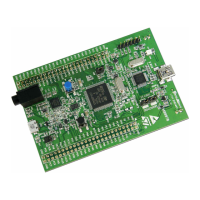The Cortex-M4 processor PM0214
34/262 PM0214 Rev 9
Reading a word in the alias region:
• 0x00000000 indicates that the targeted bit in the bit-band region is set to zero
• 0x00000001 indicates that the targeted bit in the bit-band region is set to 1
Directly accessing a bit-band region
Behavior of memory accesses on page 30 describes the behavior of direct byte, halfword,
or word accesses to the bit-band regions.
2.2.6 Memory endianness
The processor views memory as a linear collection of bytes numbered in ascending order
from zero. For example, bytes 0-3 hold the first stored word, and bytes 4-7 hold the second
stored word.
Little-endian format
In little-endian format, the processor stores the least significant byte of a word at the lowest-
numbered byte, and the most significant byte at the highest-numbered byte. See Figure 10
for an example.
Figure 10. Little-endian example
2.2.7 Synchronization primitives
The Cortex-M4 instruction set includes pairs of synchronization primitives. These provide a
non-blocking mechanism that a thread or process can use to obtain exclusive access to a
memory location. Software can use them to perform a guaranteed read-modify-write
memory update sequence, or for a semaphore mechanism.
A pair of synchronization primitives comprises:
• Load-Exclusive instruction: used to read the value of a memory location, requesting
exclusive access to that location.
• Store-Exclusive instruction: used to attempt to write to the same memory location,
returning a status bit to a register. If this bit is:
0: the thread or process gained exclusive access to memory, and the write succeeds.
1: the thread or process did not gain exclusive access to memory, and no write is
performed.
0HPRU\ 5HJLVWHU
$GGUHVV$
$
OVE\WH
PVE\WH
$
$
%%% %
%
%
%
%

